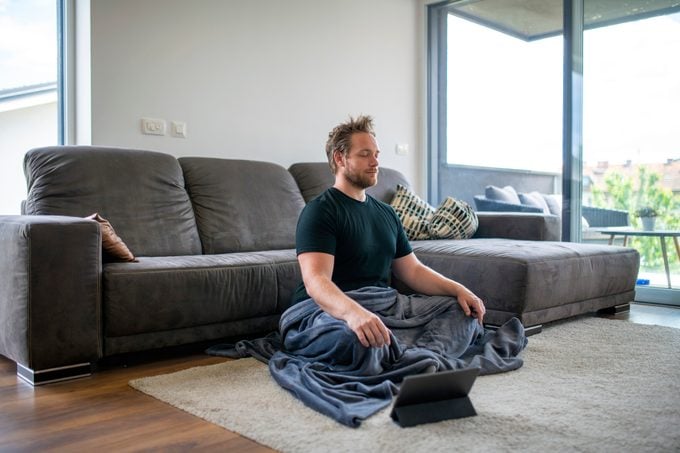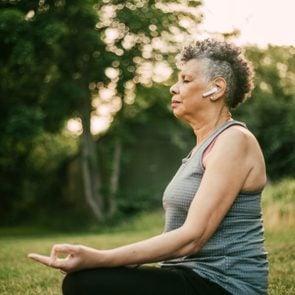What Is Guided Meditation? Here Are the Benefits and How to Get Started
Updated: Jan. 07, 2022
If you're thinking of beginning a meditation practice, guided meditation is a good place to start.
What is guided meditation?
Close your eyes and picture this: You’re kneeling by a river, feeling the grass beneath your fingertips and listening to the water bubbles over rocks.
You’re feeling very, very relaxed and safe. You pluck a leaf from a nearby tree.
Now imagine placing all of your stress, worry, and fear onto its surface.
You gently place the leaf in the river and watch as it travels downstream, taking all of your angst far, far away.
Relaxing, right? You just did a form of guided meditation.
It’s a mind-body practice where an experienced teacher walks you through the meditative process and often describes relaxing images and scenarios to set the tone and mood.
It is sometimes called guided imagery or visualization. Guided meditation is not the same thing as hypnosis.
All forms of meditation are growing in popularity, thanks to their potential mental and physical benefits.
Meditation’s use has more than tripled, going from 4.1 percent in 2012 to 14.2 percent in 2017, according to the Centers for Disease Control and Prevention.
And with anxiety and fear stoked by the ongoing Covid-19 pandemic, even more people are giving meditation a try.
How to start a meditation practice
Don’t know where to begin? Guided meditations is great for newbies.
You don’t have to shell out big bucks either. There are free meditation sources, all with guided options, and these free meditation apps let you try the different types of meditation.
Most types of meditation can be guided. Mindfulness meditation brings your attention to the here and now by focusing on your breath.
Transcendental meditation calls for repeating a personalized mantra over and over to clear your mind. Body scan meditation and progressive muscle relaxation bring awareness to every part of your body, starting at your toes and working up to your head.
All of these can be done solo or with the help of a guide.
Some meditation practices are insight focused and ask you to set your intentions for the day or express gratitude or appreciation.
Guides can help walk you through these practices as well. The guide doesn’t always talk throughout the entire meditation.
There are usually periods of silence, relaxing music, or sounds sprinkled throughout the session.
Guided meditation benefits
If you meditate regularly, you will likely see a host of physical and mental health benefits.
This holds true for all types of meditation, including guided practices.
Boosts mental health
Practicing meditation may reduce blood pressure, symptoms of irritable bowel syndrome, anxiety, depression, and insomnia, according to the National Center for Complementary and Integrative Health.
According to a study published in 2019 in Behavioral Brain Research, when people who had never meditated before did a 13-minute guided meditation session daily for eight weeks, they reported less anxiety, fewer negative moods, and reduced fatigue.
They also improved memory and attention compared with counterparts who listened to a podcast instead.
Improves sleep
If you have trouble dozing, mindfulness tricks can help you fall asleep faster.
Guided meditation also may improve your sleep, according to a study in the January 2021 issue of PLOS One.
When people who had difficulty getting a good night’s sleep practiced guided mindfulness meditations using the Calm app for eight weeks, they were less tired during the day and had less trouble falling asleep at bedtime, compared with peers who didn’t meditate.
Relaxes the mind
You can accrue mental health dividends from regular guided meditation practices.
Guided meditation can prime your mind to relax on its own, says Kimberly Quinn, a psychology professor and the well-being/success program coordinator at Champlain College in Burlington, Vermont.
“The guide may ask you to picture yourself in your happy place,” she says. “And the brain likes patterns, so if you are continually visualizing yourself in a calm, happy place, your brain will begin to do this on its own in time.”
Another potential benefit of guided meditation is that when your mind wanders—and it will—the guide’s voice can gently bring you back to the present.
This is a skill that you can (and will) learn to do on your own, but beginners often appreciate the guidance. Imagine taking a solo hike in a new area with nothing but a paper map.
Now imagine going with a guide. Chances are, you are less likely to get lost and wander off if you have a guide.
(Try these breathing exercises for relaxation.)

How to practice guided meditation
Find a quiet, comfortable spot. Do your best to get rid of any possible distractions: your pets, your phone, and any other devices that may beep, buzz, or otherwise interrupt your zen.
Next, pick a meditation position. You can sit, stand, or lie down where you feel comfortable.
Just make sure you’re not so comfortable that you risk falling asleep. Close your eyes, and follow the guide’s instructions.
You don’t have to dedicate huge chunks of time to meditation.
Sure, you could dedicate an hour to meditation, but even short sessions—like these eight mini meditations—can help you relieve stress and anxiety.
How long you meditate is not as important as how often you do it.
How to choose your meditation guide
It’s important that you are able to connect with and trust your guide, says Beth King, an assistant professor of nursing at Florida Atlantic University’s Christine E. Lynn College of Nursing in Boca Raton, Florida.
She teaches a form of meditation known as HeartMath, which uses biofeedback to help people better control their stress, anxiety, and depression.
“A lot of times, [whether you connect with a guide] depends on their tone of voice,” she says. “You also need to connect with where the person is taking you in the visualization exercises.”
(Learn more about practicing meditation for depression.)
When’s the best time for guided meditation?
Just as with other meditation practices, there is no best time of day or night for guided meditation.
Some people prefer to start their day with morning meditation, but others would rather do it before bed or in the early evening.
The meditation process
It takes time to start feeling the difference that a regular meditation practice can make in your day-to-day life.
Give yourself one to three months before drawing any conclusions about whether your practice is helpful to you, says Cortland Dahl, chief contemplative officer at Healthy Minds Innovations and a research scientist at the Center for Healthy Minds at the University of Wisconsin-Madison.
Meditation is generally considered safe for healthy people, but it can make some people feel more anxious.
Listen to your body.
There are many free guided meditations that can help you get started. Some people cultivate a practice with guided meditation and then progress to doing it on their own, while others enjoy having a guide well past the beginner stage.
Go with whatever works best for you and helps you keep a consistent practice.



